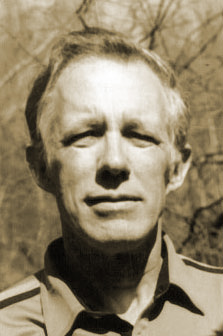From The Fame of a Dead Man’s Deeds:
An Up-Close Portrait of William Pierce
by Robert Griffin
In late 1997 I wrote Pierce a letter broaching the idea of writing a book about him and his ideas. In the letter, I said:
I’m not talking about anything authorized, that is to say, where explicitly or implicitly I have the job of fronting for you, making you look good, selling you. But at the same time, I wouldn’t be aiming to demonize you or set you up as a straw man to serve some agenda of my own. I also don’t want to play a game academics often play [I am a university professor], which is to stand above their subjects, as it were, and patronizingly critique them and make themselves look good in the process. What I do want to do is focus on the issues you raise and the ideas you affirm and your current activities within the context of the events and circumstances of your life, and to present it as objectively as I can. Whatever else comes through, I want who you are and what you are and where you have come from put out there for readers straight and true. I am not interested in exposes or inside journalism. I am interested in where this culture and society is heading and how we live our individual lives, and what you and what you represent have to do with that.
Pierce wrote back:
Your idea is an intriguing one. I am not convinced that the things I have accomplished to date merit a biography—although I always am trying to acquire more merit. From a practical point of view, if you succeed in getting a biography of me published and it is not a hatchet job, it should be helpful. Although you might be subject to pressure from your publisher to produce a book fitting a certain stereotype of me and my message. Anyway, it is a project that I am willing to discuss with you.
I wrote back to Pierce that I wasn’t planning on writing a full-scale, detailed biography, bringing in multiple sources and perspectives and all. Rather, I was thinking of something akin to what goes on between a subject posing for a portrait and an artist. That is to say, the book would essentially be about him and me: the way he presents himself to me and the way I make sense of and render that presentation. I said I wanted to hear him talk about his life growing up and what he has done as an adult. I wanted to learn about the circumstances in society and the people and experiences and ideas that have had an impact on him. I wanted to become familiar with the books that have made a difference to him—I’ d like to read them if I haven’t—and see if I can learn why they affected him as they did. I wanted to look at how his public life and private life have affected one another. I wanted to do those things in order to paint a picture of him, so to speak. So a portrait would be a more accurate way of referring to what I had in mind than a biography.
And, really, I said in the letter, I am not setting out to do a hatchet job on you. I am not intending to write a judgmental book; rather, I want to be a vehicle that will allow readers the chance to get a good look at you and to decide for themselves what they see. I told Pierce I would stay away from slanting or channeling people’ s impression of him by tacking negative labels on him—neo-Nazi, anti-Semite, bigot, hater. However, he had to understand that after hearing what he has to say and reviewing what he has done with his life, readers may well decide that, indeed, those labels suit him. And as for publishers pushing me to fit him into a certain stereotype—he had mentioned that possibility—I told him that I was not going to bend reality for anybody.
I told Pierce that I wanted to meet him in person—I hadn’t at that point—and talk more about this project and see if it seemed as if the two of us could work together. I said I thought a couple of hours with one another should give us a good sense of whether we ought to keep exploring this idea.
Pierce said that was all right with him, and I went to see him in West Virginia. This was in the fall of 1997. We talked for two hours in the afternoon at his office in the National Alliance headquarters building on his three hundred forty-six acre plot of land. Basically, we got acquainted. He asked me about what things were like at the university where I am on the faculty, and we talked about university politics for a time. I thought the session went well. Pierce seemed open and unthreatened—I had expected more wariness, which would have been understandable—and he was congenial and expansive. At the end of that first meeting, we decided that I should come back and spend a full work day at the property.
